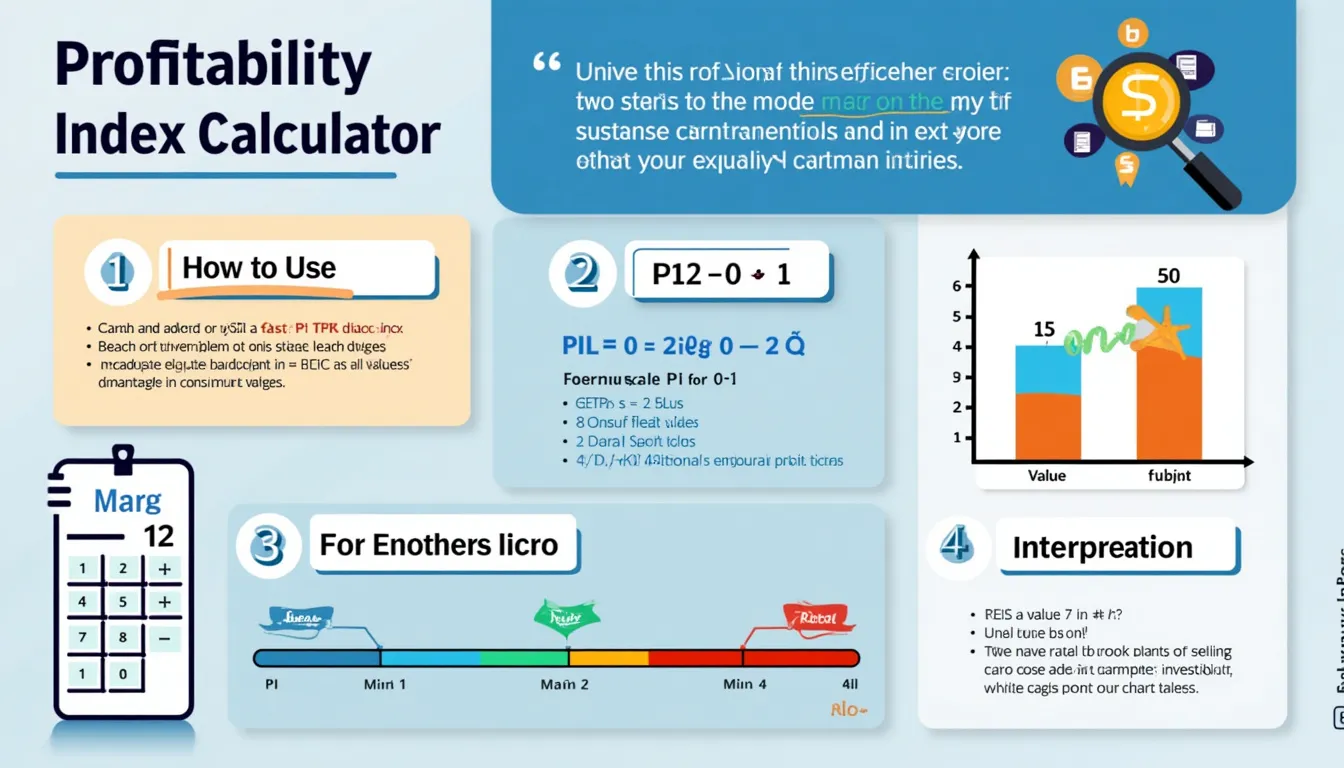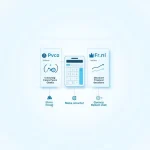Profitability Index Calculator
Is this tool helpful?
How to Use the Profitability Index Calculator Effectively
Our Profitability Index Calculator is designed to help you assess the potential profitability of your investment projects quickly and accurately. Here’s a step-by-step guide on how to use this powerful tool:
- Enter the Initial Investment: Input the total upfront cost of your project in USD. This is the amount you’ll invest at the beginning of the project.
- Input Annual Cash Flows: Enter the expected annual cash flows for each year of the project, separated by spaces. For example, if your project is expected to generate $1000 in the first year, $1500 in the second year, and $2000 in the third year, you would enter “1000 1500 2000”.
- Specify the Discount Rate: Enter the discount rate as a percentage. This rate represents the time value of money and the risk associated with the investment. For instance, if you’re using a 10% discount rate, enter “10”.
- Calculate: Click the “Calculate” button to generate your Profitability Index.
- Interpret the Results: The calculator will display your Profitability Index. A value greater than 1 indicates a potentially profitable investment, while a value less than 1 suggests the investment may not be financially viable.
Understanding the Profitability Index: Definition, Purpose, and Benefits
The Profitability Index (PI), also known as the Profit Investment Ratio (PIR) or Value Investment Ratio (VIR), is a crucial financial metric used in capital budgeting to evaluate the potential profitability of proposed investments or projects. It’s a ratio that compares the present value of future cash inflows to the initial investment required for a project.
The primary purpose of the Profitability Index is to help businesses and investors determine whether a project or investment is worth pursuing. It provides a clear, quantitative measure of an investment’s potential return relative to its cost, allowing for easy comparison between different investment opportunities.
The Mathematical Formula for Profitability Index
The Profitability Index is calculated using the following formula:
$$ PI = \frac{\text{Present Value of Future Cash Flows}}{\text{Initial Investment}} $$Where:
- Present Value of Future Cash Flows is the sum of all future cash flows, discounted to their present value
- Initial Investment is the upfront cost of the project or investment
For a more detailed calculation, we can expand this formula to:
$$ PI = \frac{\sum_{t=1}^{n} \frac{CF_t}{(1+r)^t}}{I_0} $$Where:
- CFt is the cash flow in year t
- r is the discount rate
- n is the number of years
- I0 is the initial investment
Key Benefits of Using the Profitability Index Calculator
Utilizing our Profitability Index Calculator offers numerous advantages for investors, financial analysts, and business decision-makers:
- Quick and Accurate Calculations: Our calculator eliminates the need for complex manual calculations, saving you time and reducing the risk of errors.
- Informed Decision Making: By providing a clear profitability metric, the calculator helps you make more informed investment decisions.
- Easy Comparison of Investment Options: The Profitability Index allows for straightforward comparison between different investment opportunities, even if they have different initial costs or cash flow patterns.
- Risk Assessment: By incorporating the discount rate, the calculator helps you account for the time value of money and investment risk.
- Capital Budgeting Support: For businesses, the Profitability Index is an essential tool in the capital budgeting process, helping to allocate resources efficiently.
- Long-term Financial Planning: The calculator aids in long-term financial planning by providing insights into the potential profitability of projects over time.
Addressing User Needs: How the Profitability Index Calculator Solves Specific Problems
Our Profitability Index Calculator is designed to address several key challenges faced by investors and financial decision-makers:
1. Simplifying Complex Financial Calculations
Calculating the Profitability Index manually can be time-consuming and prone to errors, especially when dealing with multiple cash flows over several years. Our calculator automates this process, allowing you to input your data and receive accurate results instantly. This simplification enables you to focus on analyzing the results rather than getting bogged down in complex calculations.
2. Facilitating Investment Comparison
When faced with multiple investment opportunities, it can be challenging to compare them objectively, especially if they have different initial costs or cash flow patterns. The Profitability Index provides a standardized metric that allows for easy comparison. Our calculator enables you to quickly compute the PI for different projects, facilitating side-by-side comparisons and helping you identify the most promising investments.
3. Incorporating Time Value of Money
One of the key challenges in evaluating long-term investments is accounting for the time value of money. Our calculator addresses this by incorporating the discount rate into its calculations. This ensures that future cash flows are appropriately discounted to their present value, providing a more accurate representation of the investment’s potential profitability.
4. Balancing Risk and Return
Assessing the risk-return tradeoff is crucial in investment decision-making. The Profitability Index Calculator helps address this challenge by allowing you to adjust the discount rate. Higher discount rates can be used for riskier investments, while lower rates can be applied to safer options. This flexibility enables you to evaluate investments in light of their specific risk profiles.
5. Optimizing Capital Allocation
For businesses with limited capital, deciding which projects to pursue can be challenging. Our Profitability Index Calculator helps solve this problem by providing a clear metric for ranking investment opportunities. This allows companies to allocate their capital more efficiently, prioritizing projects with the highest potential returns relative to their costs.
6. Enhancing Long-term Financial Planning
Long-term financial planning requires a clear understanding of how investments will perform over time. By allowing you to input projected cash flows for multiple years, our calculator provides insights into the long-term profitability of investments. This helps in creating more robust financial plans and strategies.
Practical Applications: Examples and Use Cases
To illustrate the practical utility of our Profitability Index Calculator, let’s explore some real-world examples and use cases:
Example 1: Comparing Two Manufacturing Equipment Investments
A manufacturing company is considering two different pieces of equipment:
- Machine A:
- Initial Investment: $100,000
- Annual Cash Flows: $30,000 for 5 years
- Discount Rate: 10%
- Machine B:
- Initial Investment: $150,000
- Annual Cash Flows: $45,000 for 5 years
- Discount Rate: 10%
Using our calculator:
For Machine A:
- Initial Investment: 100000
- Annual Cash Flows: 30000 30000 30000 30000 30000
- Discount Rate: 10
- Result: Profitability Index = 1.14
For Machine B:
- Initial Investment: 150000
- Annual Cash Flows: 45000 45000 45000 45000 45000
- Discount Rate: 10
- Result: Profitability Index = 1.14
In this case, both machines have the same Profitability Index, suggesting they are equally attractive investments relative to their costs. The company might consider other factors, such as maintenance costs or operational efficiency, to make the final decision.
Example 2: Evaluating a Real Estate Investment
An investor is considering purchasing a rental property:
- Purchase Price (Initial Investment): $300,000
- Expected Annual Rental Income (after expenses):
- Year 1: $20,000
- Year 2: $21,000
- Year 3: $22,000
- Year 4: $23,000
- Year 5: $24,000
- Expected Sale Price after 5 years: $350,000
- Discount Rate: 8% (based on alternative investment opportunities and risk assessment)
Using our calculator:
- Initial Investment: 300000
- Annual Cash Flows: 20000 21000 22000 23000 374000 (including the sale price in the final year)
- Discount Rate: 8
- Result: Profitability Index = 1.22
With a Profitability Index of 1.22, this real estate investment appears to be potentially profitable, as the present value of future cash flows exceeds the initial investment by 22%.
Example 3: Assessing a New Product Launch
A technology company is considering launching a new product line:
- Initial Development and Marketing Costs: $500,000
- Projected Cash Flows:
- Year 1: -$50,000 (additional marketing expenses)
- Year 2: $100,000
- Year 3: $200,000
- Year 4: $300,000
- Year 5: $400,000
- Discount Rate: 12% (reflecting the high risk of new product launches)
Using our calculator:
- Initial Investment: 500000
- Annual Cash Flows: -50000 100000 200000 300000 400000
- Discount Rate: 12
- Result: Profitability Index = 1.31
The Profitability Index of 1.31 suggests that this new product launch could be a profitable venture, with the present value of future cash flows exceeding the initial investment by 31%.
Frequently Asked Questions (FAQ)
1. What does the Profitability Index tell us?
The Profitability Index indicates the relative profitability of an investment by comparing the present value of future cash flows to the initial investment. A PI greater than 1 suggests a potentially profitable investment, while a PI less than 1 indicates that the investment may not be financially viable.
2. How is the Profitability Index different from Net Present Value (NPV)?
While both metrics consider the time value of money, the Profitability Index is a ratio, while NPV is an absolute measure. PI allows for easier comparison between projects of different sizes, while NPV gives the actual dollar value added by the project.
3. What’s a good Profitability Index?
Generally, a Profitability Index greater than 1 is considered good, as it indicates that the present value of future cash flows exceeds the initial investment. However, many companies set a higher threshold (e.g., 1.2 or 1.3) to ensure a margin of safety.
4. Can the Profitability Index be negative?
No, the Profitability Index cannot be negative. The lowest possible value is 0, which would occur if the present value of future cash flows is zero. A PI between 0 and 1 indicates an unprofitable investment.
5. How does the discount rate affect the Profitability Index?
A higher discount rate will result in a lower Profitability Index, as it reduces the present value of future cash flows. Conversely, a lower discount rate will increase the PI.
6. Can I use the Profitability Index for investments with different lifespans?
Yes, the Profitability Index can be used to compare investments with different lifespans. However, it’s important to ensure that the discount rate and risk assessments are appropriate for each investment’s duration.
7. Is the Profitability Index the only metric I should consider when making investment decisions?
While the Profitability Index is a valuable tool, it shouldn’t be the only factor in investment decisions. Other metrics like NPV, IRR, and payback period, as well as qualitative factors, should also be considered for a comprehensive evaluation.
8. How accurate is this Profitability Index Calculator?
Our calculator uses standard financial formulas to compute the Profitability Index. However, the accuracy of the results depends on the accuracy of the inputs provided. It’s important to note that we can’t guarantee that the webtool or results from our webtool are always correct, complete, or reliable. Our content and tools might have mistakes, biases, or inconsistencies.
Conclusion: Harnessing the Power of the Profitability Index Calculator
The Profitability Index Calculator is an invaluable tool for investors, financial analysts, and business decision-makers. By providing a clear, quantitative measure of an investment’s potential profitability relative to its cost, it enables more informed and confident decision-making in various financial contexts.
Key benefits of using our Profitability Index Calculator include:
- Quick and accurate calculations, saving time and reducing errors
- Easy comparison of different investment opportunities
- Incorporation of the time value of money and risk assessment
- Support for capital budgeting and resource allocation decisions
- Enhanced long-term financial planning capabilities
Whether you’re evaluating a new business venture, considering a real estate investment, or prioritizing projects within your organization, our Profitability Index Calculator provides the insights you need to make sound financial decisions.
We encourage you to leverage this powerful tool in your investment analysis process. By inputting your project’s initial investment, expected cash flows, and discount rate, you can quickly obtain a Profitability Index that will help guide your decision-making. Remember to use this metric in conjunction with other financial analyses and qualitative factors for a comprehensive evaluation of your investment opportunities.
Start using our Profitability Index Calculator today and take the first step towards more informed, data-driven investment decisions!
Important Disclaimer
The calculations, results, and content provided by our tools are not guaranteed to be accurate, complete, or reliable. Users are responsible for verifying and interpreting the results. Our content and tools may contain errors, biases, or inconsistencies. We reserve the right to save inputs and outputs from our tools for the purposes of error debugging, bias identification, and performance improvement. External companies providing AI models used in our tools may also save and process data in accordance with their own policies. By using our tools, you consent to this data collection and processing. We reserve the right to limit the usage of our tools based on current usability factors. By using our tools, you acknowledge that you have read, understood, and agreed to this disclaimer. You accept the inherent risks and limitations associated with the use of our tools and services.







